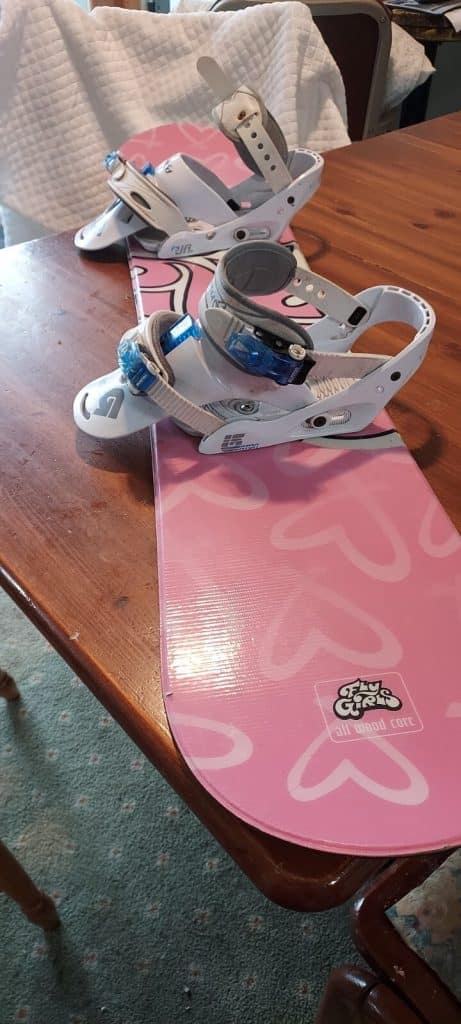Trying to figure out if you should buy a men’s or women’s snowboard? You’re not the only one. I’ve lost count of how many times I’ve had riders in the shop ask if they have to buy the “women’s” model or if that’s just marketing fluff. Spoiler: a lot of it is marketing fluff.
Back in the day, women’s boards were literally just smaller, softer, and painted with pastel flowers. Men’s boards looked like tattoo flash art or someone’s favorite metal album. Thankfully we’ve moved on, but the confusion still lingers.
So let’s cut through it. Here’s what actually changes between “men’s” and “women’s” snowboards, and why you probably don’t need to stress so much about the label.
Flex: Softer vs Stiffer
Most women’s boards are built with a softer flex. That makes them easier to turn and more forgiving, especially at slower speeds or when you’re still building confidence. Men’s boards, on the other hand, usually skew stiffer, which works better for heavier or more aggressive riders.
Here’s the kicker: it’s not about gender. It’s about weight, style, and strength. I’ve seen women hate a soft board because it felt twitchy underfoot. I’ve also seen smaller dudes look like they were fighting a 2×4 because they bought into the idea they had to ride a stiff “men’s” board.
Waist Width: It’s Really About Your Boots
Forget the “men’s vs women’s” talk for a second — what matters here is boot size. Women’s boards usually run narrower, men’s boards wider. If you’ve got bigger boots and you’re on a narrow deck, you’re going to be boot-dragging all day. If you’re in tiny boots on a wide deck, you’ll feel like you’re steering a door.
Quick rule of thumb: you want just enough toe and heel overhang to get leverage without catching snow. That’s it.
Length: Shorter Doesn’t Mean “Women’s”
Yes, women’s boards often come in shorter lengths, but board size should match your height, weight, and riding style — not the label on the topsheet. I know women who rip on 160cm directional sticks and guys who ride 148cm jib boards because that’s what fits their style. Ignore the “for him” or “for her” sizing guides and go by your body and your goals.
Graphics: Don’t Get Me Started
Once upon a time, women’s graphics were flowers, butterflies, and random swirls. Men’s graphics were skulls, flames, and screaming eagles. It was all very… gendered. These days it’s much better. A lot of brands offer neutral designs, and you can always find something that doesn’t scream “this was designed by a 14-year-old boy.” Ride the board you like looking at. Function first, but if you love the graphic, that’s a bonus.


Tech and Materials: The Gap is Closing
For years, brands treated women’s boards like the little sister model. Less tech, fewer options, sometimes even cheaper construction. That sucked. But companies like Jones, GNU, Burton, and others have stepped it up — now a lot of women’s boards get the same core builds as the men’s line. That said, in the budget ranges, you’ll still occasionally see men’s boards packed with more “premium” tech.
Marketing: The Real Villain
This is where I get salty. Brands love to tell us men want to “charge and dominate” while women want “comfort and control.” It’s nonsense. Riding style is about personality, not gender. I know women who bomb double blacks faster than most guys I’ve ridden with. I know dudes who’d rather butter down the cat track all day. Don’t buy the marketing story. Buy the board that fits.
So Are Snowboards Actually Unisex?
Pretty much, yeah. As long as the size, width and flex work for you, ride whatever. Plenty of the best all-mountain boards are basically unisex already.
I’ve seen women happily riding “men’s” boards for extra stiffness and length, and I’ve seen smaller guys riding “women’s” boards because they wanted something softer and more playful. Nobody cared what label was printed on the topsheet once they were riding.
My Take
The right snowboard has less to do with gender and everything to do with fit and feel. Look at your boot size, your weight, your riding style, and your terrain. That’s what matters.
Demo if you can. Borrow from friends. Test what feels good. Don’t let a marketing label talk you out of the board you’re actually stoked on.
Because at the end of the day, the mountain doesn’t care what gender your snowboard was marketed to. It just cares whether you’re having fun on it.
Not Sure What Board You Need?
A snowboard’s label - “men’s” or “women’s” - is just the start. Fit, flex, length and width matter way more. Let our tool crunch the numbers, so you land on the right board for your actual specs.
Find Your Ideal Board →